
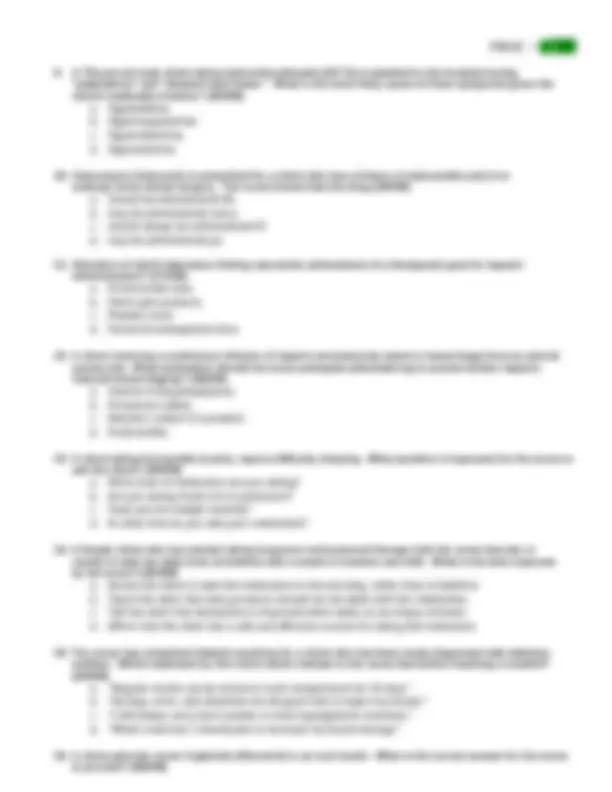
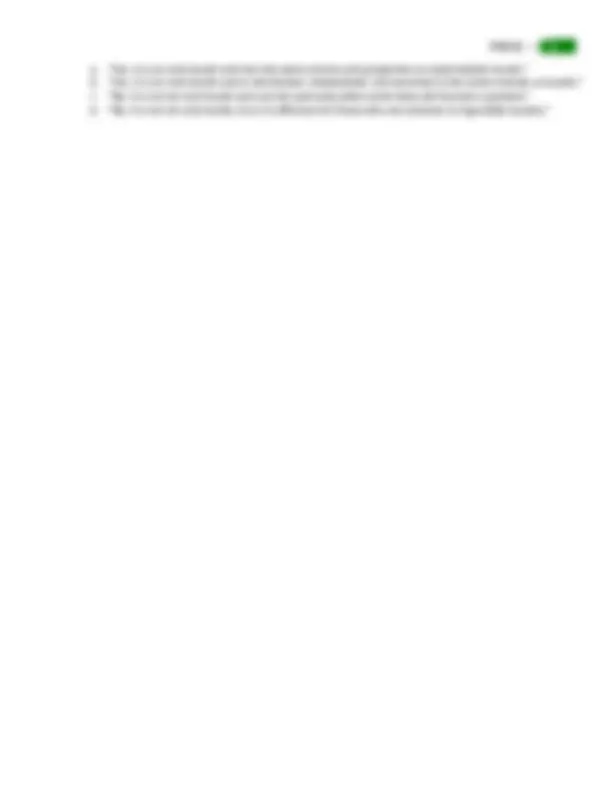
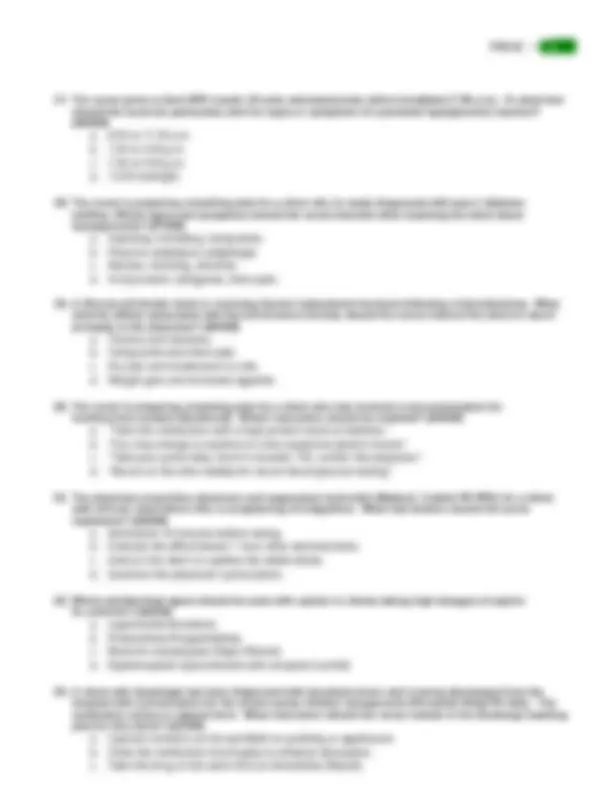
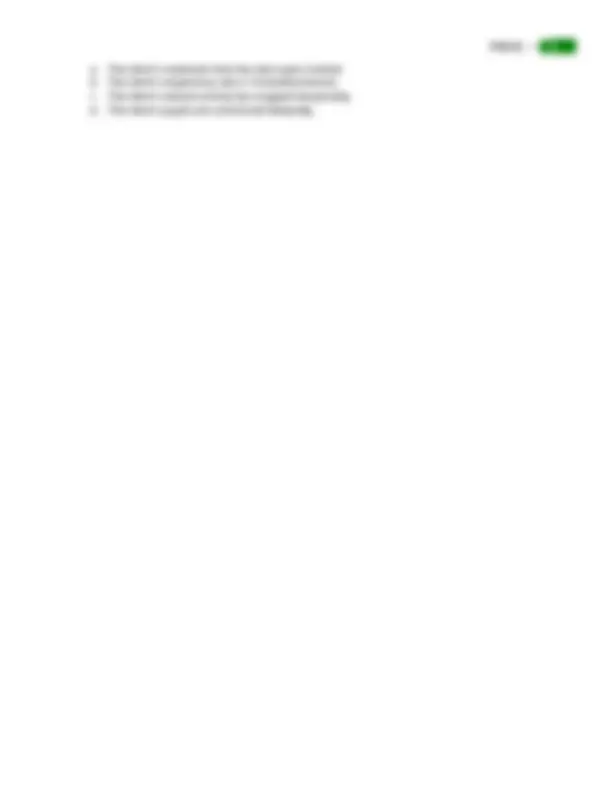
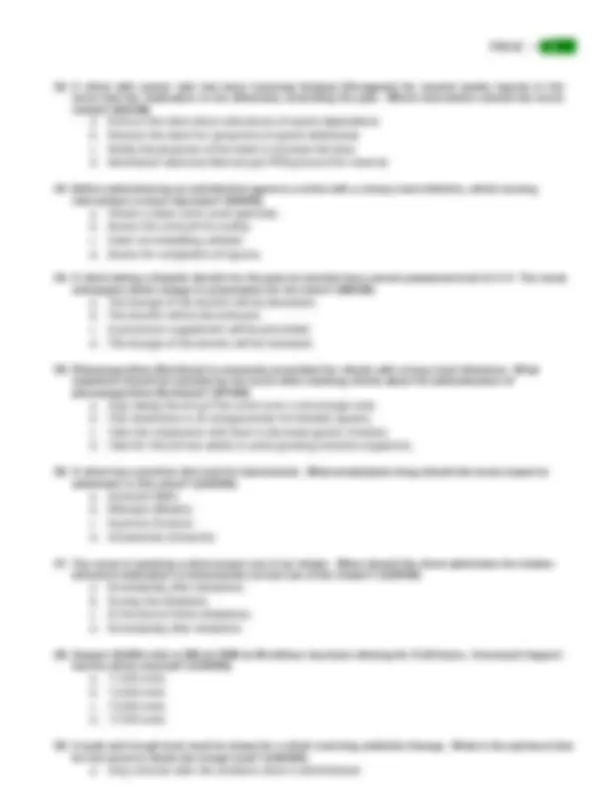
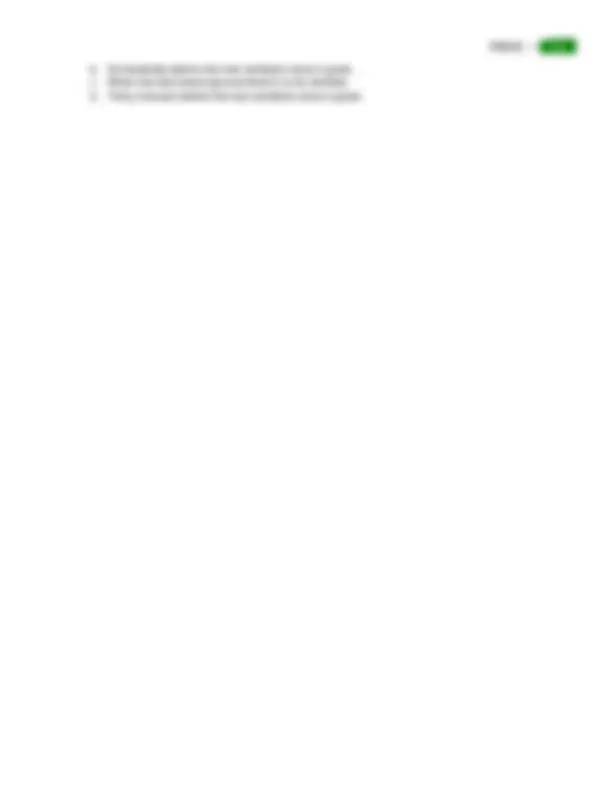
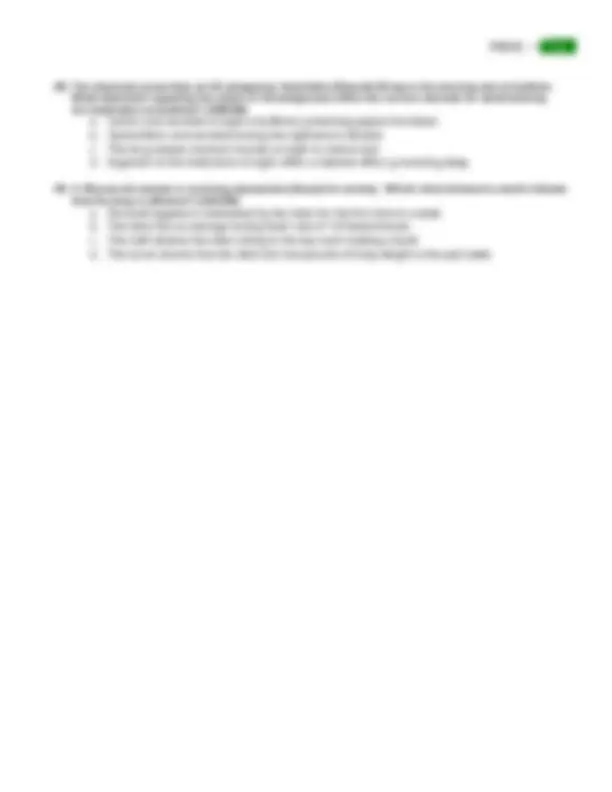
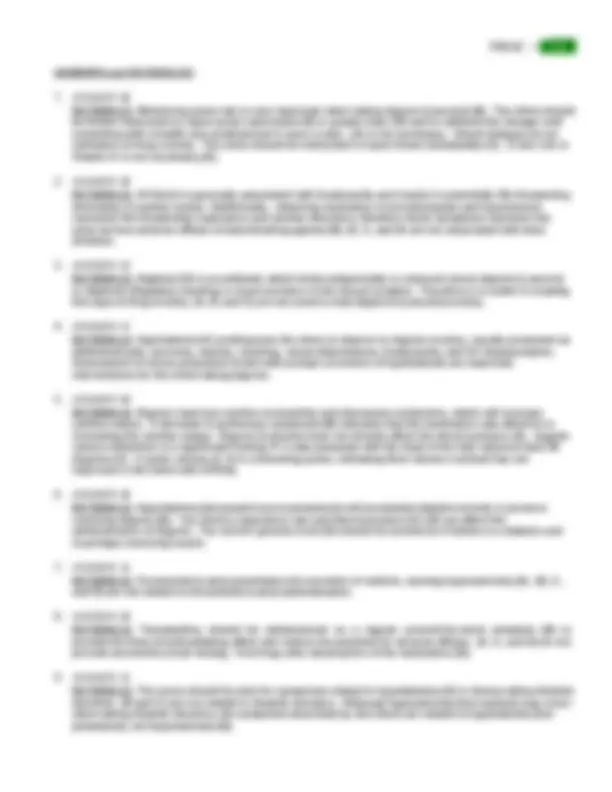
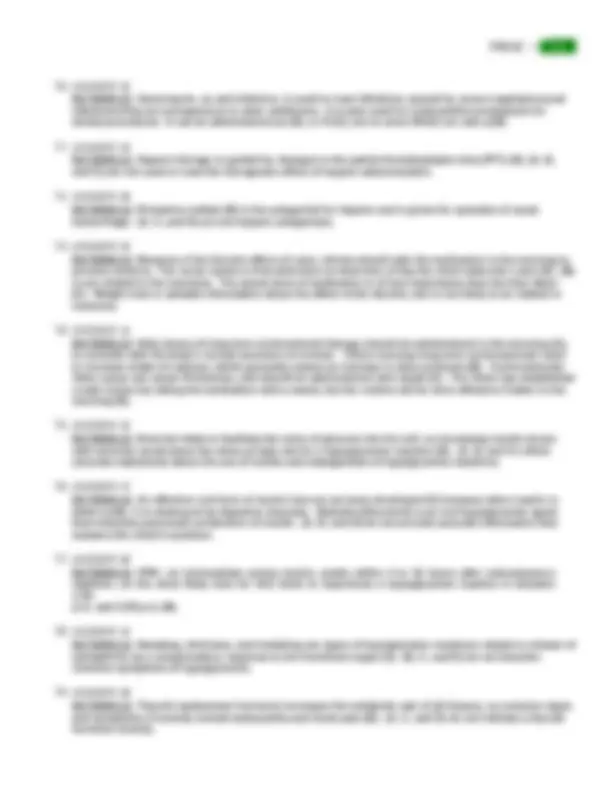
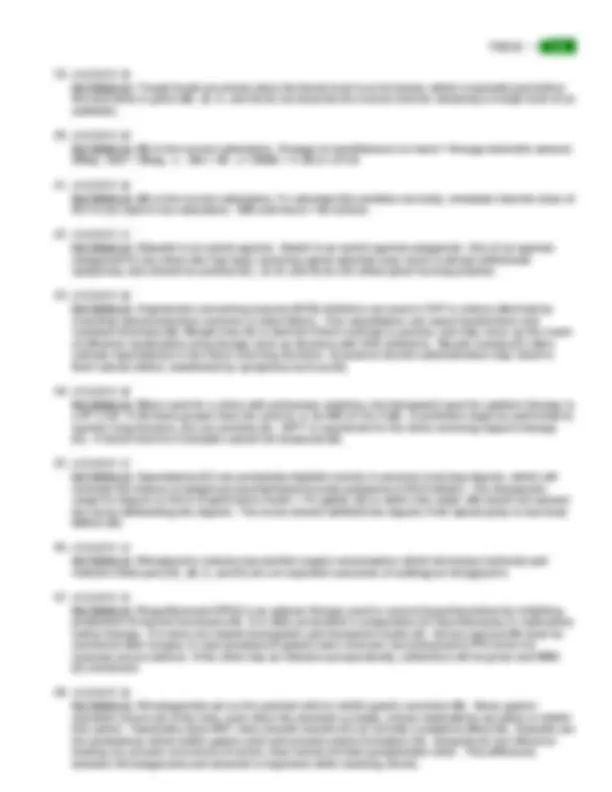
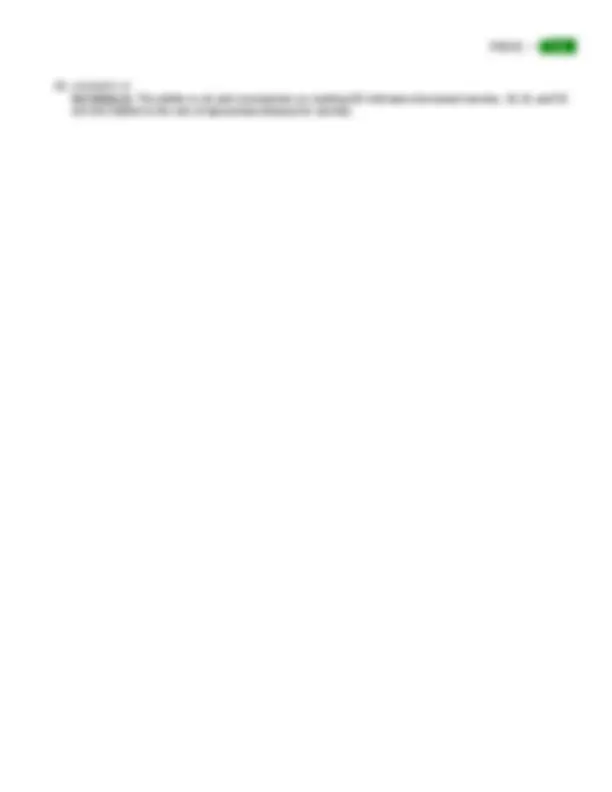


Study with the several resources on Docsity

Earn points by helping other students or get them with a premium plan


Prepare for your exams
Study with the several resources on Docsity

Earn points to download
Earn points by helping other students or get them with a premium plan
Community
Ask the community for help and clear up your study doubts
Discover the best universities in your country according to Docsity users
Free resources
Download our free guides on studying techniques, anxiety management strategies, and thesis advice from Docsity tutors
NURSING 1426 PHARMACOLOGY EXAM QUESTIONS WITH ANSWERS
Typology: Exams
1 / 19

This page cannot be seen from the preview
Don't miss anything!












discharge, timed-release capsules are not available, which dosing schedule should the nurse advise the client to follow? (14/150) a. 9 a.m., 1 p.m., and 5 p.m. b. 8 a.m., 4 p.m., and midnight. c. Before breakfast, before lunch and before dinner. d. With breakfast, with lunch, and with dinner.
a. "Yes, it is an oral insulin and has the same actions and properties as intermediate insulin." b. "Yes, it is an oral insulin and is distributed, metabolized, and excreted in the same manner as insulin." c. “No, it is not an oral insulin and can be used only when some beta cell function is present." d. “No, it is not an oral insulin, but it is effective for those who are resistant to injectable insulins."
a. The client's statement that the chest pain is better. b. The client's respiratory rate is 16 breaths/minute. c. The client's seizure activity has stopped temporarily. d. The client's pupils are constricted bilaterally.
b. Immediately before the next antibiotic dose is given. c. When the next blood glucose level is to be checked. d. Thirty minutes before the next antibiotic dose is given.
ANSWERS and RATIONALES
RATIONALE: Monitoring pulse rate is very important when taking digoxin (Lanoxin) (B). The client should be further instructed to report pulse rates below 60 or greater than 110 and to withhold the dosage until consulting with a health care professional in such a case. (A) is not necessary. Visual changes are an indication of drug toxicity. The client should be instructed to report these immediately (C). A diet rich in Vitamin K is not necessary (D).
RATIONALE: AV block is generally associated with bradycardia and results in potentially life-threatening decreases in cardiac output. Additionally, wheezing secondary to bronchospasm and hypotension represent life-threatening respiratory and cardiac disorders, therefore these symptoms represent the most serious adverse effects of beta-blocking agents (B). (A, C, and D) are not associated with beta- blockers.
RATIONALE: Digibind (D) is an antibody which binds antigenically to unbound serum digoxin (Lanoxin) or digitoxin (Digitalis) resulting in renal excretion of the bound complex. Therefore it is useful in treating this type of drug toxicity. (A, B, and C) are not used to treat digitoxin (Lanoxin) toxicity.
RATIONALE: Hypokalemia (C) predisposes the client on digoxin to digoxin toxicity, usually presented as abdominal pain, anorexia, nausea, vomiting, visual disturbances, bradycardia, and AV disassociation. Assessment of serum potassium levels with prompt correction of hypokalemia are important interventions for the client taking digoxin.
RATIONALE: Digoxin improves cardiac contractility and decreases conduction, which will increase cardiac output. A decrease in pulmonary symptoms (B) indicates that the medication was effective in increasing the cardiac output. Digoxin (Lanoxin) does not directly affect the blood pressure (A). Jugular venous distention is a significant finding, IF it was assessed with the head of the bed raised at least 30 degrees (C). A pulse volume of +4 is a bounding pulse, indicating fluid volume overload has not improved in the client with CHF(D).
RATIONALE: Hypokalemia (decreased serum potassium) will precipitate digitalis toxicity in persons receiving digoxin (B). The client's respiratory rate and blood pressure (C) will not affect the administration of digoxin. The client's glucose level (D) should be monitored if he/she is a diabetic and is perhaps receiving insulin.
RATIONALE: Furosemide (Lasix) potentiates the excretion of sodium, causing hyponatremia (A). (B, C, and D) are not related to furosemide (Lasix) administration.
RATIONALE: Theophylline should be administered on a regular around-the-clock schedule (B) to provide the best bronchodilating effect and reduce the potential for adverse effects. (A, C, and D) do not provide around-the-clock dosing. Food may alter abosorption of the medication (D).
RATIONALE: The nurse should be alert for symptoms related to hypokalemia (A) in clients taking thiazide diuretics. (B and C) are not related to thiazide diuretics. Although hyponatremia (low sodium) may occur when taking thiazide diruetics, the symptoms described by this client are related to hypokalemia (low potassium), not hyponatremia (D).
RATIONALE: Levothyroxine sodium (Synthroid) should be withheld if the pulse is over 100 beats per minute (C). To prevent insomnia, the daily dose should be taken early in the morning before breakfast, not at bedtime (A). Product brands should not be changed (B) without consulting the physician because the intended effects and side effects of different formulations of the medication can vary. Serum glucose (D) is not affected by thyroid preparations, so weekly blood testing is not required.
RATIONALE: Magnesium agents are not usually used for clients with renal failure due to the risk of hypermagnesemia, so this prescription should be questioned by the nurse (D). Administering the drug before eating (A), evaluating effects within one hour (B), and instructing the client to swallow the tablet whole (C) are not recommended nursing actions for the administration of aluminum and magnesium hydroxide (Maalox).
RATIONALE: Bismuth subsalicylate (Pepto Bismol) contains a subsalicylate that increases the potential for salicylate toxicity when used concurrently with aspirin (acetacylic acid, another salicylate preparation). (A, B, and D) do not pose the degree of risk of drug interaction with aspirin as bismuth subsalicylate (Pepto Bismol) would.
RATIONALE: Lansaprozole (Prevacid) is administered PO in capsule form. Capsules contain enteric- coated granules to prevent decomposition of the drug in the acidic pH of the stomach. The granules can be sprinkled on semi-solid foods such as pudding or applesauce (A) for those who have difficulty swallowing capsules. The medication should not be chewed (B) so that the enteric-coated granules can remain intact. This medication should not be taken concomitantly with H2-receptor blockers such as famotidine (Pepcid) (C). This drug should be administered 30 minutes before, not after, meals (D).
RATIONALE: Lack of abdominal pain within 4 hours after eating indicates decreased duodenal irritation (D), a positive outcome in treatment of duodenal ulcer. Gastric secretions (A) would not offer an indication of the effectiveness of the medication. A positive hemoccult test on 2 occasions (B) indicates that duodenal bleeding may be unchecked, but that information is unrelated to the action of this medication. A decrease in epigastric "burning" (C) relates to control of gastroesophageal reflux, another indication for the use of this drug, but it is not indicative of control of duodenal ulcer pain.
RATIONALE: Shrimp, oysters, and other shelled seafoods are iodine-rich foods which act as antagonists to Lugol's solution, so they should be avoided by this client (D). (A, B, and C) can be safely consumed when the client is taking Lugol's solution.
RATIONALE: Docusate sodium and sasantrol (Peri-colace) is a stool softener that prevents the use of Valsalva's maneuver (straining) for defecation (A). The therapeutic effects described in (B, C, and D) are not related to the use of this medication.
RATIONALE: Lovenox is a low molecular weight heparin which can only be administered subcutaneously, so the nurse should contact the physician to clarify the route of administration (D). (A and B) are important nursing interventions, but not necessary to the administration of this medication. The client should be instructed about medication side effects (C), but this is of less priority than obtaining a correct prescription.
RATIONALE: Stomatitis caused by a thrush infection, which can cause mouth pain, are signs of superinfection (A). (B, C, and D) are symptoms more typical of side effects, rather than a superinfection.
RATIONALE: Tinnitus is an early sign of salicylate toxicity. The health care provider should be notified immediately (C), and the medication discontinued. (A and D) are not needed, and (B) is inaccurate.
RATIONALE: Cyclobenzaprine (Flexeril) is a central skeletal muscle relaxant used to relieve muscle spasms, so improved range of motion (C) would be an expected outcome of therapy. It does not have analgesic propreties, so it would not be used to control joint pain (B). Although it is related to tricyclic antidepressants, it is not effective with depression (A) or treatment of seizures (D).
RATIONALE: Naloxone (Narcan) is a narcotic antagonist that reverses the respiratory depression effects of opiate overdose, so assessment of a normal respiratory rate (B) would indicate that the respiratory depression has been halted. (A, C, and D) are not related to naloxone (Narcan) administration.
RATIONALE: Clients can develop a tolerance to the analgesic effect of opioids, and may require an increased dose (C) for effective long term pain relief. The client is not exhibiting indications of dependence (A), withdrawal (B), or toxicity (D).
RATIONALE: A clean catch urine specimen (A) is used to determine the causative organism, and to evaluate the effectiveness of pharmacologic therapy in treating the source of the infection. The initial specimen should be obtained prior to beginning treatment with the antiinfective agent (A). (B, C, and D) are not essential to complete prior to administration of the antiinfective.
RATIONALE: This client's potassium level is too low (normal is 3.5-5.0). Taking a thiazide diuretic often results in a loss of potassium, so a potassium supplement needs to be prescribed to restore a normal serum potassium level (C). (A, B, and D) are not recommended actions for restoring a normal serum potassium level.
RATIONALE: Phenazopyridine (Pyridium), a urinary analgesic used to relieve pain associated with chronic urinary tract infections, can be taken with food to decrease gastric irritation (C). It will typically cause the urine to turn a red-orange color, so it should not be discontinued if this occurs (A). It is not effective in relieving bladder spasms (B). Pyridium should only be used for 2 days (D) when taken together with an antibacterial agent, which is typically prescribed for approximately 2 weeks.
RATIONALE: Isoniazid (INH) is the drug of choice for treatment of clients with positive skin tests for tuberculosis (A).
RATIONALE: The client should be instructed to deliver the medication during the last part of inhalation (B). After the medication is delivered, the client should remove the mouthpiece, keeping his/her lips closed and breath held for several seconds to allow for distribution of the medication. The client should not deliver the dose immediately after exhalation (A) or after inhalation (D), and should deliver no more than two inhalations at a time (C).
RATIONALE: (A) is the correct calculation: 20,000 units/500 ml = 40 units (the amount of units in one ml of fluid). 40 units/ml x 50 ml/hr = 2,000 units/hour (1,000 units in 1/2 hour). 5.5 x 2,000 = 11,000 (A). OR, multiply 5 x 2,000 and add the 1/2 hour amount of 1,000 to reach the same conclusion = 11,000 units.
RATIONALE: The ability to sit and concentrate on reading (C) indicates decreased anxiety. (A, B, and D) are not related to the use of alprazolam (Xanax) for anxiety.